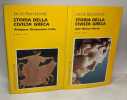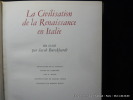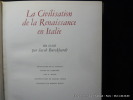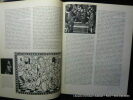80 books for « burckhardt jacob »Edit
-
Century
19th (5)
20th (36)
-
Countries
Belgium (4)
Denmark (3)
France (54)
Switzerland (19)
-
Syndicate
ILAB (38)
NVVA (6)
SLACES (6)
SLAM (24)
Topics
- Aesthetics (1)
- Architecture (1)
- Basel (2)
- Civilisation (3)
- Cooking (1)
- Europe (1)
- Fine arts (4)
- First edition (1)
- Geography (2)
- German literature (3)
- Germanic languages (8)
- Germany (1)
- Gold (1)
- Gothic (1)
- Greece (1)
- Guide books (1)
- Helvética (2)
- History (22)
- History of art (1)
- Hugo victor (2)
- Italian (2)
- Italy (14)
- Jacob (79)
- Literature (3)
- Painting (1)
- Sculpture (1)
- Sociology (1)
- Switzerland (2)
- Various (1)
Die Zeit Constantin's des Grossen. - [REINTERPRETING GIBBON]
Basel, 1853. 8vo. A little later green hcloth w. simple handwritten paper title label to spine. Some leaves brownspotted. VII, (1), 512 pp.
First edition of the first publication of any of Burckhardt's books, his fist major publication, the important and influential ""The Age of ConstantinE the Great"".Burckhardt's ""The Age of Constantine the Great"" was the first work to describe an ""Age of Constantine"". It was also the first work of a series of cultural histories that Burckhardt had planned. The series was supposed to begin with the age of Pericles and end with that of Raphael, and that of Constantine became the first to appear. The work founded the basic structure of his other later cultural histories, namely representing what he considered the three great powers: state, religion and culture. Burckhardt eminently describes transitional periods and periods of crises, and this work deals with the transition from late pagan Antiquity to early Christian Middle Ages.The age of Constantine is here considered as the necessary transition from Antiquity to the Christian era and as such it is also understood as the basis of the culture of the Middle Ages. In opposition to the historians of his time, Burckhardt portrayed the Emperor Constantine negatively, as a calculating politician only concerned with preserving his own power, whose turn toward Christianity was purely speculative and driven by politics. He is thus portrayed as wholly unreligious and as having the sole goal of dominion. The work and the portrayal of Constantine caused the greatest controversies within religious and historical circles. The work became hugely influential and many later historians were inspired by both the controversial portrayal of Constantine, which they applied to other historical figures as well, as well as of Burckhardt's theories of the transition between the two eras. The Swiss historian of art and culture, Jacob Chrisoph Burckhardt (1818-1897), contributed seminally to the historiography of these two fields. He is considered the discoverer of the Renaissance, and with his later main work, ""Die Cultur der Renaissance in Italien"", he founded the study of thirteenth- to fifteenth-century Italy and thereby the historical study of the Renaissance, the society of which he dealt with all aspects of. In general, Burckhardt's works all constitute an original historical approach to the study of art, culture, social institutions etc. As a highly respected scholar of Greek civilization, Burckhardt, with his original historiographical approach, was highly admired by Nietzsche, who also attended his lectures. The two kept in contact and corresponded frequently. Like Nietzsche, Burckhardt was a great admirer of Schopenhauer, and he greatly opposed the Hegelian interpretations of history.""Outstanding among his (Burckhardt's) writings are, besides the books on Italian art and civilization, ""The Age of Constantine the Great"", 1853, in which he reinterpreted Gibbon, and the two posthumously published books..."" (PMM, p. 210).
Die Cultur der Renaissance in Italien. - [FOUNDING THE HISTORICAL STUDY OF THE RENAISSANCE - PMM 347]
Basel, 1860. 8vo. A little later green half cloth with a recent printed paper title-label to spine. Brownspotting to some leaves. Some underlinings and maginal annotations, all in pencil. Near contemporary annotations/description pasted on to verso of dedication-leaf. (4), 576 pp.
The scarce first edition of Burckhardt's main work, the groundbreaking work on the culture of the Renaissance, which helped found the historical study of this previously much overlooked era. "" ""The most penetrating and subtle treatise on the history of civilization"", in Lord Acton's words, ""a mere essay"", as Burckhardt himself called it, ""The Civilization of the Renaissance in Ittaly"" has, for more than a century, determined the general conception of thirteenth- to fifteenth-century Italy."" (PMM p. 210)This classic of Renaissance historiography is of the greatest importance to the development of the history of the Renaissance and of history of art and culture in general. More specifically, Burckhardt here establishes the fact that the Renaissance came first in developing the human individuality to the highest degree. He places the earliest signs of ""the modern European Spirit"" in Florence, which was a great contributing factor to the comprehension of this city as representing one of the highlights of European culture.The Swiss historian of art and culture, Jacob Chrisoph Burckhardt (1818-1897), contributed seminally to the historiography of these two fields. He is considered the discoverer of the Renaissance, and with his main work he founded the study of thirteenth- to fifteenth-century Italy and thereby the historical study of the Renaissance, the society of which he dealt with all aspects of. In general, Burckhardt's works all constitute an original historical approach to the study of art, culture, social institutions etc. As a highly respected scholar of Greek civilization, Burckhardt, with his original historiographical approach, was highly admired by Nietzsche, who also attended his lectures. The two kept in contact and corresponded frequently. Like Nietzsche, Burckhardt was a great admirer of Schopenhauer, and he greatly opposed the Hegelian interpretations of history.""... as in the case of other great historians such as Gibbon, Ranke, Macaulay, no criticism of details can detract from the powerful spell which Burckhardt's book has exercised upon such widely different writers as Ruskin, Nietzsche and Gobineau, as well as upon innumerable lovers of the most magnificent period of European history."" (PMM).Printing and the Mind of Man 347.
Jacob Burckhardt. La Civilisation de la Renaissance en Italie : Edie Kultur der Renaissance in Italiene essai. Traduction de H. sic pour L. Louis Schmitt revue... par R. Robert Klein
Le Livre de poche Broch D'occasion bon tat 01/01/1966 302 pages
Le Cicerone guide de l'art antique et moderne en Italie1re PartieL'Art Ancien
Firmin-Didot & Cie, Paris, 1885. In-12, percaline marron, titre doré sur le plat supérieur et le dos, xlvi-200 pp. - pl. Jacob Burckhardt, sa vie et sesœuvres, par A. Gérard - Avis - Indication des plans placés à la fin du volume - Table géographique - Table des noms d'artistes - Art Ancien : I. Architecture. - II. Sculpture. - III. ...
Avec 4 plans sous serpente en fin de volume, dont deux dépliants.Traduit de l'allemand par Auguste Gérard, sur la cinquième édition, revue et complétée par le Docteur Wilhelm Bode, directeur au musée de Berlin. --- Plus d'informations sur le site archivesdunord.com
Phone number : 01 42 73 13 41
La civilisation de la Renaissance en Italie tome 2
LGF - Livre de Poche Broch D'occasion bon tat 15/03/2002 443 pages
La Civilisation De La Renaissance En Italie Three Volume Set
Le Livre De Poche Broch D'occasion bon tat 01/01/1958 100 pages
Civilisation de la Renaissance en Italie - Tome 2 , traduction de H. Schmitt, revue et corrigée par Robert Klein
Editions Gonthier , Médiations Malicorne sur Sarthe, 72, Pays de la Loire, France 1964 Book condition, Etat : Bon broché, sous couverture imprimée éditeur blanche, illustrée d'un portrait de profil de Savonarole, couleurs bronze In-8 1 vol. - 235 pages
cahier central avec 16 planches hors-texte d'illustrations en noir et blanc (complet) édition de 1964 (collection médiations) Contents, Chapitres : 1. Découverte du monde et de l'homme : Voyages des italiens - Science de la nature en Italie - Découverte de la beauté de la nature - Découverte de l'homme, description poétique - La biographie - Peuples et villes - Peinture de l'homme extérieur - Peinture de la vie active - 2. La sociabilité et les fêtes : Nivellement des classes - Raffinements extérieurs de la vie - Le langage comme base de la sociabilité - La forme supérieure de la sociabilité - L'homme de société accompli - Situation de la femme - La vie domestique - Les fêtes - 3. Moeurs et religion : La moralité - La religion dans la vie quotidienne - La religion et l'esprit de la Renaissance - Mélange de superstitions antiques et modernes - Affaiblissement général de la foi - Notes, index des noms cités, biographie et bibliographie couverture un peu jaunie, sinon en bon état, intérieur propre, papier legerement jauni, cela reste un bon exemplaire du tome 2 seul de cette série de Jacob Burckhardt sur la Civilisation de la Renaissance en Italie, complet en lui-même, et complet également des 16 planches d'illustrations en noir et blanc - format de poche
Civilisation de la Renaissance en Italie - Tome 2 , traduction de H. Schmitt, revue et corrigée par Robert Klein
Editions Gonthier , Médiations Malicorne sur Sarthe, 72, Pays de la Loire, France 1964 Book condition, Etat : Bon broché, sous couverture imprimée éditeur blanche, illustrée d'un portrait de profil de Savonarole, couleurs bronze In-8 1 vol. - 235 pages
cahier central avec 16 planches hors-texte d'illustrations en noir et blanc (complet) édition de 1964 (collection médiations) Contents, Chapitres : 1. Découverte du monde et de l'homme : Voyages des italiens - Science de la nature en Italie - Découverte de la beauté de la nature - Découverte de l'homme, description poétique - La biographie - Peuples et villes - Peinture de l'homme extérieur - Peinture de la vie active - 2. La sociabilité et les fêtes : Nivellement des classes - Raffinements extérieurs de la vie - Le langage comme base de la sociabilité - La forme supérieure de la sociabilité - L'homme de société accompli - Situation de la femme - La vie domestique - Les fêtes - 3. Moeurs et religion : La moralité - La religion dans la vie quotidienne - La religion et l'esprit de la Renaissance - Mélange de superstitions antiques et modernes - Affaiblissement général de la foi - Notes, index des noms cités, biographie et bibliographie dos bruni, plats de la couverture un peu jaunis, le coin inférieur droit du plat inférieur est à peine corné sans gravité, intérieur propre, papier un peu jauni, cela reste un bon exemplaire du tome 2 seul de cette série de Jacob Burckhardt sur la Civilisation de la Renaissance en Italie, complet en lui-même, et complet également des 16 planches d'illustrations en noir et blanc - format de poche
La Civilisation De La Renaissance En Italie Ii
Denoel Gonthier Broch D'occasion bon tat 01/01/1963 150 pages
La Civilisation De La Renaissance En Italie.
Le Club Du Meilleurs Livre Broch D'occasion bon tat 01/01/1958 150 pages
Neuere Kunst seit 1550.Aus dem Nachlass herausgegeben von Eva Mongi-Vollmer und Wilhelm Schlink.“Jacob Burckhardt Werke. Kritische Gesamtausgabe, Band 18.”
München - Basel, C. H. Beck - Schwabe 2006, 230x155mm, IX- 1363Seiten, Verlegereinband mit Umschlag. Exemplar wie neu.
Pour un paiement via PayPal, veuillez nous en faire la demande et nous vous enverrons une facture PayPal
La civilisation de la Renaissance en Italie - Tome 1 , traduction de H. Schmitt, revue et corrigée par Robert Klein, préface de Robert Klein
Editions Gonthier , Médiations Malicorne sur Sarthe, 72, Pays de la Loire, France 1964 Book condition, Etat : Bon broché, sous couverture imprimée éditeur blanche, illustrée d'un buste avec un casque vert In-8 1 vol. - 232 pages
16 planches hors-texte d'illustrations en noir et blanc (complet) édition de 1964 Contents, Chapitres : 1. L'Etat considéré comme création d'art : Introduction - La tyrannie au Xive siècle - La tyrannie au Xve siècle - Les petits tyrans - Les grandes maisons régnantes - Les adversaires de la tyrannie - Les Républiques : Venise et Florence - Politique extérieure des états italiens - La guerre considérée comme un art - La papauté et ses dangers - 2. Développement de l'individu : L'Etat italien et l'individu - Entier développement de l'individu - La gloire moderne - La raillerie et le mot d'esprit - 3. La résurrection de l'Antiquité : Rome, la ville aux ruines célèbres - Les auteurs anciens - L'Humanisme au quatorzième siècle - Les universités et les écoles - Les promoteurs de l'Humanisme - Reproduction de l'Antiquité, épistolographie et discussion - Les traités en latin et l'histoire - Latinisation générale de la culture - La période néo-latine - L'échec des humanistes - Notes et index couverture et papier un peu jaunis, sinon bon état, intérieur propre, bien complet des 16 planches hors-texte - tome 1 seul sur 3 de cette série de Burckhardt, complet en lui-même - format de poche
Burckhardt gesammelte Werke. In 6 Bde zus. - 1) Richelieu. 2) Betrachtungen zur Geschichte und Literatur. 3) Meine Danziger Mission. 1937-1939. 4) Porträts und Begegnungen. 5) Erzählungen Helvetica. 6) Briefe 1919-1969.
Scherz, 1971, in-8vo, Insges. 2526 S., Original-Leinenband. OU.

(SLACES, NVVA)
Phone number : 41 (0)26 3223808
civilisation de la renaissance en Italie 2 [Mass Market Paperback]
Poche état correct .Couverture jaunie . 1966.443 pages . PHOTOS SUR DEMANDE
Merci de nous contacter à l'avance si vous souhaitez consulter une référence dans notre boutique à Authon-du-Perche.
Die Cultur der Renaissance in Italien. Ein Versuch. Achte, durchgearbeitete Auflage von Ludwig Geiger.
2 Bände. Leipzig, Verlag von E.A. Seemann, 1901. 8°. XYXIV, 382 S., 2 S. Anzeigen; IX, 405 S., 1 S. Anzeigen. Lederbände mit 5 Bünden, goldgeprägten Rückentiteln und geometrischem Rückendekor in Gold und Rot, Kopfgoldschnitt.
Gestochenes heraldisches Exlibris «Semper Progrediens», Name entfernt, signiert mit den Initialen AK. Exlibris für Rudolf von Gutmann, österreichischer Bankier und bedeutender Kunst- und Büchersammler. Als Jude wurde seine Kunstsammlung konfisziert. Er flüchtete 1938 in die Tschechoslowakei und über die Schweiz nach Victoria, British Columbia. - Sauberes Exemplar in einem äusserst dekorativem Einband, vorgebundenes weisses Blatt mit dem Etikett "Ancienne Librairie E. Flammarion& A. Vaillant, Ernest Martin Suc."
La Civilisation de la Renaissance en Italie.
Le Club Du Meilleur Livre, Plon 1958 In-4 reliure éditeur pleine toile sous rhodoïd, 27,5 cm sur 21,5. 354 pages. Bon état d’occasion.
Bon état d’occasion
Description de la cathédrale de Basle et de ses curiosités.
Basle, Hasler & Cie, 1842. Petit in-folio broché, couv. moderne verte reproduisant la p. de titre, 23 pp., 1 plan dépliant et 18 planches en lithographie.
Rare, bien complet de toutes les illustrations en lithographie d'après les dessins de Constantin Guise. Rouss. marg. très modérées, un pli du plan un peu usé mais n'affectant pas le dessin, bonne condition. - Frais de port : -France 4,95 € -U.E. 9 € -Monde (z B : 15 €) (z C : 25 €)
Storia della civilta greca VOLUME 1: tomo 1-2-3 + VOLUME 2: Tomo: 1-2
Sansoni 1992 in8. 1992. Cartonné jaquette. 5 volume(s).
Très bon état de conservation intérieurs prorpes bonne tenue avec leur jaquette
Schmuckeli.
Olten, Vereinigung Oltener Bücherfreunde, 1956. 8°. (3) Bl., 82 (4) S., (4) Bl. Orig.-Halblederband. = "Vereinigung Oltener Bücherfreunde", 4269. Publikation.
Eins von 100 (GA 602) Exemplaren.
Schuckeli.
Olten, Vereinigung Oltener Bücherfreunde, 1956. 8°. (4) Bl., 82 (4) S., (4) Bl. Orig.-Halblederband in Schuber. = "Vereinigung Oltener Bücherfreunde", 69. Publikation.
Eins von 100 (GA 602) Exemplaren.
CONSIDERATIONS SUR L'HISTOIRE UNIVERSEL
ALLIA EDITIONS
LIVRE A L’ETAT DE NEUF. EXPEDIE SOUS 3 JOURS OUVRES. NUMERO DE SUIVI COMMUNIQUE AVANT ENVOI, EMBALLAGE RENFORCE. EAN:9782844850744
CIVILISATION DE LA RENAISSANCE EN ITALIE. 2 Tomes.
Paris, LE LIVRE DE POCHE,, BIBLIO, 1988; 2 volumes in-12 brochés,, 275 & 443 pp. Couverture en bon état, intérieur en très bon état.
Der Cicerone. Eine Anleitung zum Genuss der Kunswerke Italiens. Dritte Auflage unter Mitwirkung von mehreren Fachgenossen bearbeitet von A. von Zahn.
4 Teile in 3 Bänden. Leipzig, E.A. Seemann. 1874. Klein-8°. 418 S.; S. 419-779; S. 780-1172, XII, 61 S. Register. Schwarze Halblederbände der Zeit auf 4 Bünden mit goldgeprägtem Rückentitel und Bundvergoldung.
Erste von Wilhelm Bode herausgegebene Auflage. - Exlibris von Bally-Forcart auf den Innendeckeln. - Rückenkanten leicht beschabt. - Schönes sauberes Exemplar in guten Einbänden.
The civilization of the renaissance in italy an essay - complete & unabridged - 100 illustrations with a commentary
Phaidon press 1965 in12. 1965. Cartonné jaquette.
Très Bon Etat de conservation intérieur propre bonne tenue
BURCKHARDT Jacob . Introduction de Marcel Brion. Postface de Robert Klein
Reference : 67469
(1958)
LA CIVILISATION DE LA RENAISSANCE EN ITALIE.
Paris, Plon, 1958, in-4, reliure éditeur toilée sous rhodoid, 355 pages. Très bon état. Abondante iconographie en noir. Essai complet en un volume.
NB : LES QUESTIONS ET COMMANDES SONT TRAITEES DANS LES 48H, LES ENVOIS REPRENDRONT À PARTIR DU 4 DECEMBRE, MERCI.
 Write to the booksellers
Write to the booksellers
![Description de la cathédrale de Basle et de ses curiosités.. [BURCKHARDT (Jacob)]](https://static.livre-rare-book.com/pictures/TRA/516457_1_thumb.jpg)
![Description de la cathédrale de Basle et de ses curiosités.. [BURCKHARDT (Jacob)]](https://static.livre-rare-book.com/pictures/TRA/516457_2_thumb.jpg)











